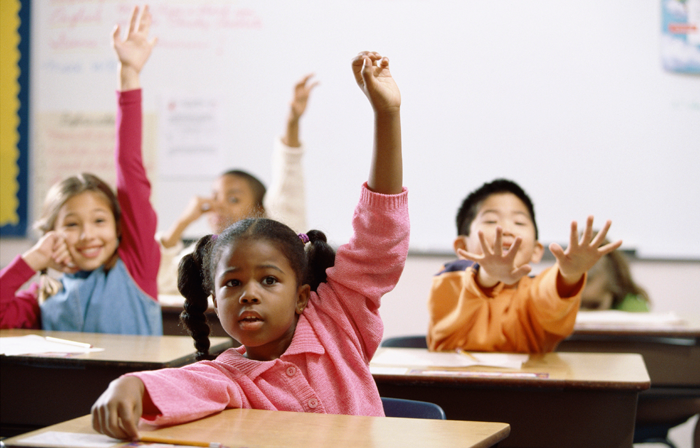Michael, a third grader who was adopted from Vietnam at the age of two, came home from school one day in tears. When his mother asked him what was wrong, he replied, “I hate school. I hate being adopted.” Upon further probing, Michael’s mother learned that, in preparation for Thanksgiving, Michael’s class was discussing the fact that most kids did not have ancestors who came to the U.S. on the Mayflower. His teacher had given the class the assignment of finding out where their ancestors came from. Intending to be “sensitive,” the teacher had told the class, “If you are adopted, you are excused from this assignment.”
Tamara, an African-American fifth-grade girl, was adopted from foster care at the age of three by white parents. She was in bed getting ready to go to sleep. After her parents kissed her good-night, she said, “During recess, some kids asked me why I don’t look like you and why my real parents didn’t want me.” Tamara’s parents asked how those questions and comments had made her feel and how she had replied. During the discussion, they asked her if any of her teachers were aware of the situation. “Oh, yes, Ms. Smith was there,” said Tamara. “She just smiled and winked at me.”
In both scenarios, dedicated, well-meaning teachers were unaware that their actions (or lack of action) were hurtful to their adopted students. Understanding adoption and adoptive families is typically not part of teachers’ educational curriculum or preparation for their work. So what can parents do to increase adoption awareness at school?
What is S.A.F.E. at School and why is it needed?
All parents want their children to be emotionally safe at school. Adoptive parents know that their children will inevitably face questions and comments about adoption, and carry the extra worry about whether their children will find the support they need at these times. Parents know that what happens at school can greatly influence how both children and teens feel about being adopted.
To assist educators in understanding how to address the needs of students who were adopted, C.A.S.E. (the Center for Adoption Support and Education, in Burtonsville, Maryland) created an in-service training called S.A.F.E. at School: Support for Adoptive Families by Educators. C.A.S.E. initially developed this training in 1998, and is currently updating the S.A.F.E. at School: Support for Adoptive Families manual for re-release in 2018.
Five Proactive Ways to Create a Positive Adoption Environment in Your School
At the heart of S.A.F.E. at School are the “5 As”—simple strategies that can make a huge impact:
1. ACCEPTANCE
Objective: Normalize adoption/adoptive families by demonstrating both personal and social acceptance of adoption as one way to build a family. Help all students understand: “Adoption is a great way to build a family.”
Treating adoption as a “secret” sends the same kind of messages as pretending to be “colorblind” when it comes to race—it tells children it is something to be ashamed of. Instead, as respected adults, educators should convey a calm, positive, relaxed attitude about adoption that normalizes it as just another way to build a family. Acceptance is best communicated through deliberate, matter-of-fact statements intertwined with ongoing conversation.
Examples:
Teacher: “I’m excited that my sister is planning to adopt a child!”
Student: “Ms. ____, did you know that Melissa is adopted?”
Teacher: “Yes, I did. She is one of several students in our school whose wonderful families are adoptive families.”
Teacher: “In our short story, today, we learn that one of the main characters was adopted. Adoption is quite common in this country, and I’m sure many of you have friends who were adopted. I also have friends who were adopted, or who have adopted their children. As you read the story, I would like you to pay attention to how this character describes his family—I think it will help you to understand that this adoptive family is just like any family….”
2. ACCURACY
Objective: Educate students about adoption/adoptive families by providing accurate information at the appropriate time and in an interesting way.
There are many opportunities for teachers to reference and normalize adoption—through books, movies, personal experience, and so on. As with any subject they teach, they should stress the importance of getting facts from reliable resources. Dramatic stories will often draw students’ attention, but teachers can remind them that these stories shouldn’t be generalized to the entire adoptive population.
Most school curricula include several opportunities to naturally reference adoption/adoptive families during lessons, including:
- Multicultural, blended, or other “non-traditional” family formations;
- Genetics or inherited characteristics;
- Immigration to the U.S.;
- Lessons on history, economics, sociology;
- Literature with adoption/foster care stories or themes around loss, grief, identity, or family;
- Current events/the news/social media;
- Observing National Adoption Month (November); discussion of famous people who have a connection to adoption.
3. ASSIGNMENTS
Objective: Adapt or expand assignments to ensure inclusion of students in adoptive families
There are some common school assignments that can be challenging for adoptees because they may exaggerate the differences in their backgrounds, reveal private information, and/or highlight missing information. They may be particularly difficult for children who experienced foster care or were adopted at an older age. These assignments include:
- Family trees
- Timelines
- Autobiographies
- Baby pictures
- Birthdays and other birth data
- Student of the Week
- Family heritage & history
- Inherited characteristics
- Sex education
- Family holidays
- Mother’s Day/Father’s Day
The best way to handle these kinds of assignments is to broaden them so that all children are offered a variety of ways to meet the teacher’s expectations. Some examples the teacher can try include:
Autobiography:
Rather than designate set dates/years for children to fill in, or set life events to plot by date, ask all children to choose their three favorite or most eventful years, or allow them to focus on only memorable events or time periods in their lives.
Family tree:
Encourage the class to make a forest of different trees, emphasizing how families can have different appearances, but many similarities. Teachers can suggest multiple branches or roots that include a range of important people, such as aunts and uncles, babysitters, grandparents, foster parents, and birth family members.
Mother’s Day/Father’s Day:
Children may have contact with birth mothers, birth fathers, other birth relatives, and former foster families. Even if a child does not, he may still want to make a card for his birth mother, as well as his adoptive mother, on Mother’s Day. Students should be permitted to make as many cards as they wish.
Student of the Week:
The practice of celebrating one child for a day or a week is designed to build self-esteem, but it can backfire for children who were adopted. Such assignments tend to highlight the differences from one family to the next, and often give classmates the green light to raise questions that children who were adopted may find difficult to answer. Adopted children may lack photos of their early life, or their photos may look unusual. Instead of biographical or family information, you can ask children to focus a poster on their likes and dislikes, hobbies, pets, and so on. If there’s a class presentation, be prepared to step in if the discussion turns to adoption (see IV. Assistance).
In middle school and high school, schoolwork may address genetics, inherited characteristics, human development, sexual responsibility, or family heritage. Such assignments can have considerable impact on adopted teens, who are already grappling with identity formation. For example, an assignment that asks children to research their family’s heritage may cause a teen to react: “How can I do this assignment? I’m not Irish like my parents. I don’t even look like them. I’ll look ridiculous trying to pretend I’m something I’m not.”
or
“This project makes me look stupid. There are other Latino kids in this school who know tons more about their heritage than I do. I can’t even speak the language, let alone understand the culture.”
Teachers do not necessarily need to alter the curricula (and may not have that option), but should make sure that all students can comfortably meet the requirements for all assignments and not feel singled out during lessons.
4. ASSISTANCE
Objective: Identify appropriate boundaries and language about adoption/adoptive families. Intervene as appropriate.
To non-adopted students (and many adults), adoption is an undeniably interesting topic, but it can be confusing or even difficult for them to comprehend. Children who were adopted can easily become the targets of intrusive questions and unkind comments out of simple curiosity, insensitivity, or intentional cruelty—and many report that these interactions are the most difficult challenges they face at school. Even children who say they feel “proud” that they were adopted may still tire of the continual stream of questions.
Knowing that their teacher or counselor is willing (and likely) to step in when questions or comments are made—with words of support about their family, or by defining appropriate boundaries—can truly make a world of difference in how children feel about themselves.
Sample questions and dialogues:
Thomas (to Erin): What happened to your real mom? Why aren’t you with her?
Teacher: Thomas, I understand that you are curious about Erin’s family, and I know you are not aware of this, but those kinds of questions are not appropriate to ask a person who was adopted. Erin’s adoption story is her private story and she can choose to share it with you if she wants to. However, I can tell you that adoption happens for many reasons, but it never means that birth parents don’t care about their children.
Sarah: How did you get adopted? Were you in an orphanage?
Emma: I was in a foster family. My mother did drugs and… (stops speaking.)
Teacher: You know, Sarah, children who were adopted don’t always like to talk about their adoption stories. It’s completely up to them. I can tell you, though, that orphanages no longer exist in our country. You have probably heard about children who came from other countries to be adopted in America; some of them may have been in orphanages.
Sam: How come Connor is adopted? Where’s his real mother?
Teacher: Connor has a real mother. You’ve seen her; she brought in cupcakes for his birthday. Are you asking about his birth mother, Sam?
Sam: Yes, the one who had him in her tummy.
Teacher: Well, first of all, adoptive moms are real moms, even though they did not give birth to their children. Adoption is a way to form a family. It is sad when a birth mother or birth father can’t take care of a child, but there are people whose job it is to help children like Connor be placed in good adoptive families, and they become a family forever.
Sam: Is that what happened to Connor?
Teacher: Connor’s adoption story is private. It’s his story to tell if he feels like it. You and I don’t need to know his story, but it is nice to know that we have adoptive families in the school! We have many kinds of families here.
5. ADVOCACY
Objective: Clarify that your school will take action to support students if comments or questions about adoption/adoptive families become invasive or offensive.
Unfortunately, adopted students do occasionally face interactions that cross the line into bullying, or even racism. An attack on a child’s family goes to the core of his or her being. Teens are no less hurt than preschoolers by comments that slice into their family makeup.
Although there are usually rules regarding discrimination related to gender, race, religion, and other characteristics, schools must make certain that family type is on this zero-tolerance list. The following statements heard by C.A.S.E. staff over the years are all examples of comments that warrant immediate intervention from school staff:
“Your country is really poor and most of the people are on drugs.”
“I’ll bet your real parents didn’t want you at all. They just dumped you.”
“So, you were a ‘mistake.’”
“You must have been pretty ugly if your mother didn’t want you.”
“You are black; you should be in a black family.”
“You should go back to where you came from.”
“Your eyes are so strange.”
Any racist remark.
Ensuring That All Kids Feel S.A.F.E.
At school, students don’t just learn to learn to read, write, and solve equations, but navigate social relationships, find role models, resolve conflicts, and are introduced to an array of differences, including race, culture, religion, learning differences, and family compositions. When schools incorporate “the five A’s” of S.A.F.E. into their teacher preparation and adoption is normalized within this context, it helps create the positive school environment that will let our children thrive.
Learn more in the S.A.F.E. at School manual. An updated version will be released by C.A.S.E. in 2018.


